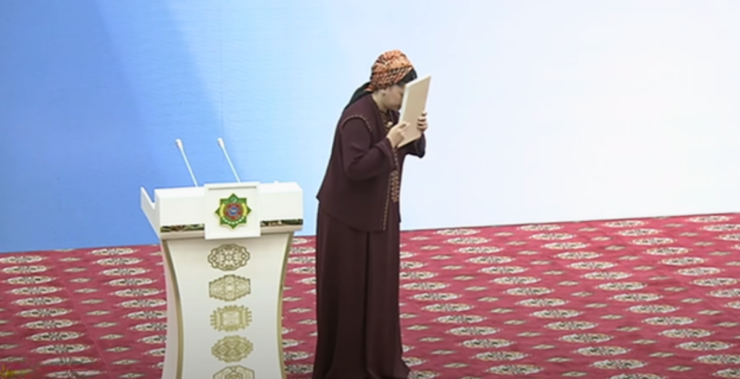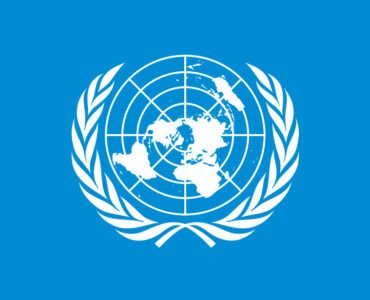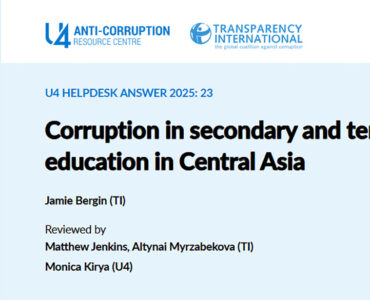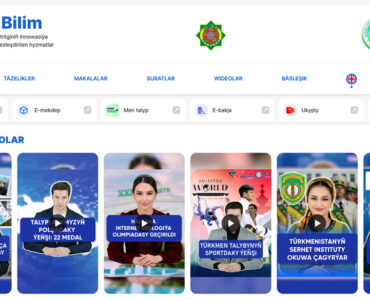During a presentation at an international conference on Eurasian studies, where I discussed Turkmenistan’s media landscape, I was asked a thought-provoking question: what is the significance of the ritual ýüzüňe sylmak, frequently depicted on Turkmen state television during ceremonies in which the state leader presents his new book, opens a new medical clinic, or when farmers receive new tractors and schoolchildren get new computers.
At such events, the public performs the ritual ýüzüňe sylmak as a sign of respect and reverence. To understand this ritual, which is common in Turkmen society, we first need to answer the question: what is its literary meaning? Ýüzüňe sylmak typically involves gently placing a gift or cherished object to the forehead, holding it close to the face, or moving the hands three times from the object to the forehead, all as a sign of admiration.
Meaning and Roots of the Act of Ýüzüňe Sylmak
This ritual is performed to signal deep respect and honor for certain objects, situations, or people within Turkmen society. These instances are culturally significant and emphasize the importance of reverence and respect for cultural or religious traditions, as well as the social order within Turkmen culture.
The act of ýüzüňe sylmak is grounded in the belief that the forehead symbolizes the soul or inner essence of a person, so bringing an object near it signifies honoring the object or wishing well-being upon oneself or others. It reflects a high value placed on the object or the gesture itself. For instance, the ýüzüňe sylmak gesture is commonly performed when witnessing the new moon, symbolizing a wish for prosperity and health in the coming lunar cycle. People also perform this gesture when greeting a newborn, signifying their wish for the growth and prosperity of the family. It represents both love and goodwill. The gesture is also commonly observed during wedding ceremonies, particularly when the bride steps into the groom’s home, symbolizing a similar wish for the couple’s future together, as well as a desire for such happiness in their own lives.
Rituals in Turkmenistan are deeply rooted in the country’s culture, blending ancient traditions, Islamic practices, and the tribal/nomadic heritage of the Turkmen people. However, the gesture of ýüzüňe sylmak – whether placing an object on the forehead, offering hands to something or someone before bringing them to the forehead, or kissing an object before doing so – carries more cultural significance than religious. While Islam, as the dominant religion, shapes many local customs, this act is more closely associated with folk traditions, drawing from broader Turkic and Central Asian practices. It is a part of a long-standing tradition in these cultures that places high value on reverence and respect. In Turkmen culture, this ritual is especially significant during special occasions or ceremonies, such as the holiday celebrations or personal milestones.
From Tradition to Political Symbolism
While ýüzüňe sylmak gesture is deeply rooted in Turkmen traditions, its meaning and practice have undergone significant evolution, particularly in the context of Soviet and post-Soviet transformations.
The Soviet system was highly effective in using symbolism to cultivate loyalty and reinforce a collective identity. For example, portraits of Lenin and members of the Politburo were prominently displayed in every classroom, symbolizing loyalty and respect for state leaders and the Communist Party’s ideology. In the post-Soviet era, Turkmenistan’s political elite continued this practice, adapting it to the rituals of the newly independent state. These symbolic gestures became central to consolidating power, reinforcing the state’s ideology, and promoting the personality cult of its leaders. Ritualized expressions of reverence, such as ýüzüňe sylmak, were not simply cultural remnants but became integral to the official state apparatus, symbolizing an ongoing commitment to the state’s authority and the omnipresence of its leadership.
Official Turkmen media often broadcast the ceremonies, in which political elites demonstrate reverence toward the president by placing his book or gift on their face, kissing it, or bringing it to their forehead. This act has come to symbolize both political loyalty and an enduring connection between the leader and the people.
Under the rule of Turkmenistan’s first president, Saparmyrat Niyazov, the government placed significant emphasis on reviving national identity, focusing particularly on Turkmen traditions and folk rituals. After Niyazov’s death in 2006, his successor, Gurbanguly Berdymukhamedov, continued this focus on state rituals and symbolism, incorporating the ritual of ýüzüňe sylmak into state ceremonies. An example from the state controlled Turkmen media illustrates how a student expresses her understanding of the ritual that has become a tool for glorifying the state leader:
Donate to support Turkmen analysts, researchers and writers to produce factual, constructive and progressive content in their efforts to educate the public of Turkmenistan.
SUPPORT OUR WORK“The Turkmen people have always placed deep respect on books. A book is a miracle that reveals the secrets of the world. In Turkmen culture, it is considered a duty to revere sacred objects by performing the ritual ofýüzüňe sylmak. The act of placing a book to one’s face symbolizes the high respect the Turkmen people have for it. Accordingly, our Hero Arkadag’s book‘Hakyda göwheri’ was welcomed by our people with great pride, as they honored it by placing it to their faces. This remarkable work has become a valuable gift for our younger generations”.
The analysis of the language and behavior of the ideology makers as presented in Turkmen media reveals the extent of the state leader’s personality cult, which can be characterized as “theatricalism”. Under Berdymukhamedov’s rule, this style evolved into a more sycophantic form. This phenomenon can be likened to a societal illness – the emergence of sycophancy, which brings significant harm to the social fabric. Sycophancy thus became a central ideology of the era.
Conclusion
Like other Central Asian republics, post-Soviet Turkmenistan experienced a revival of traditional and national identity after the fall of the Soviet Union. This resurgence led to a renewed focus on historical and cultural symbols, rituals, and practices that had been suppressed or reshaped during Soviet rule. The literature on these topics includes a mix of academic studies, ethnographic research, state-sponsored texts, and cultural critiques, all of which explore both the persistence of pre-Soviet traditions and the emergence of new state-imposed rituals under Turkmenistan’s leadership since independence (see references). While these texts may not explicitly mention ýüzüňe sylmakby name, their analysis of political symbolism, state rituals, and the construction of national identity in post-Soviet Turkmenistan is closely related to the reverence embodied in this ritual.
The act of deference, such as ýüzüňe sylmak, is integral to maintaining social order, reinforcing loyalty to the state and its leader, and cultivating a national identity.
By Oguljamal Yazliyeva, Ph.D., Charles University
References
- Berdymukhamedov Gurbanguly. Türkmeniň Döwletlilik ýörelgesi (The Principle of Statehood of the Turkmen). Aşgabat. Türkmen döwlet neşirýat gullugy. 2020.
- Clement Victoria. Religion and the Secular State in Turkmenistan. Silk Road Paper. 2020. Central Asia – Caucasus Institute, Silk Road Studies Program.
- Denison Michael. The Art of the Impossible: Political Symbolism, and the Creation of National Identity and Collective Memory in Post-Soviet Turkmenistan. Europe-Asia Studies. Vol. 61, No. 7, Politics of the Spectacular: Symbolism and Power in Central Asia, pp.1167-1187. 2009. Published by: Taylor & Francis, Ltd.
- Джикиев А. Свадебные обряды у туркмен-салыров в конце ХIХ – начале ХХ в. 1963. Тр. ИИАЭ. Т.7
- Туркмены. Традиционные обряды и праздники. Отв. Редактор Н.А. Дубова. Институт Этнологии и антропологии им. Н.Н. Микулхо-Маклая, РАН; Институт Истории АН Туркменистана. М., Наука. 2016. Стр. 294–328.
- Türkmenbaşy Saparmyrat.Ruhnama: The Book of the Soul. Volume 1 (2001), Volume 2 (2004). Turkmen State Publishing Service.
The opinions expressed in this article are those of the author. They do not necessarily reflect the opinions or views of the editorial group and other authors who write for the publication. Progres.online creates a space for the expression of diverse opinions in Turkmenistan.
Photo:
Screenshot from Watan habarlary,
January 25, 2025






